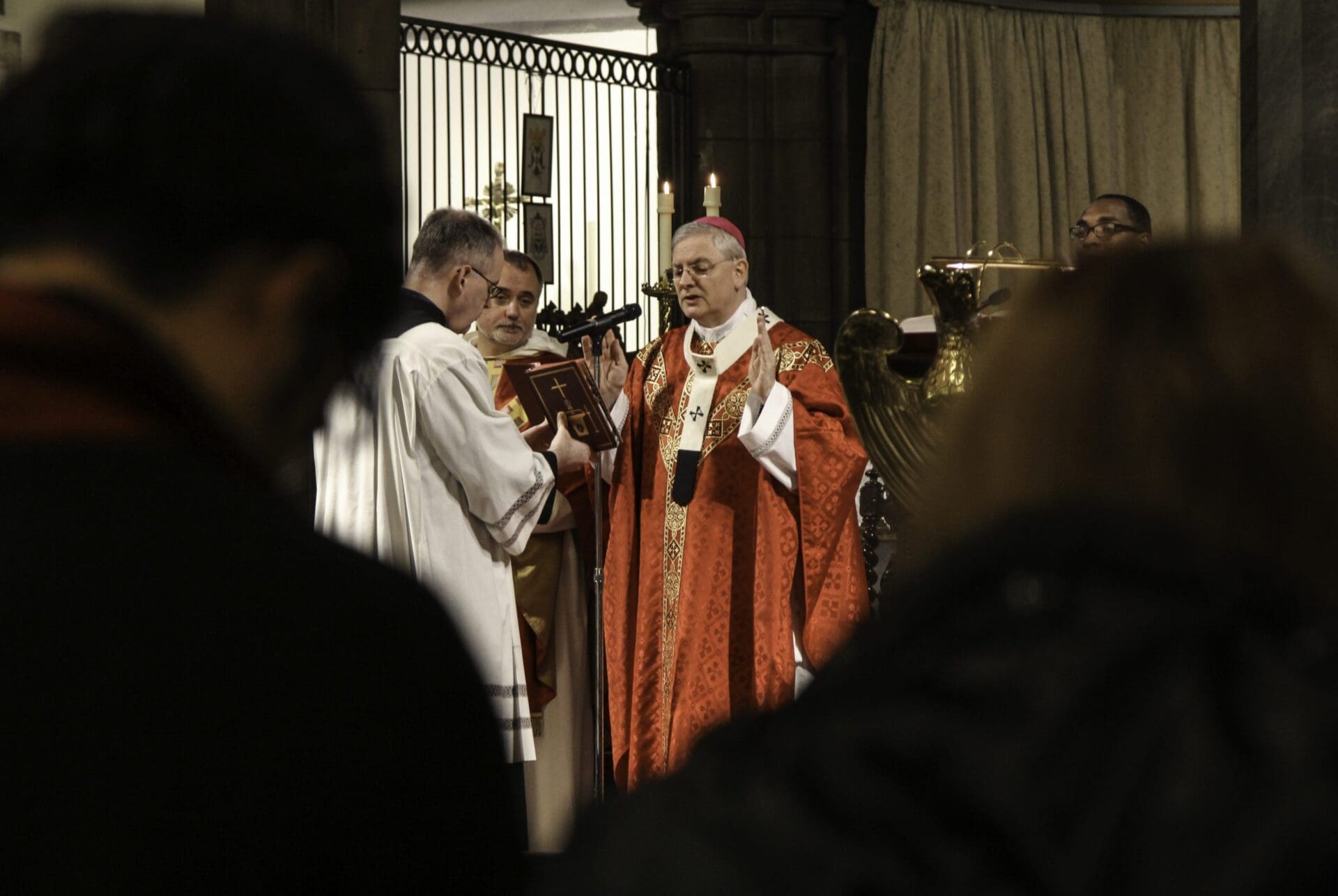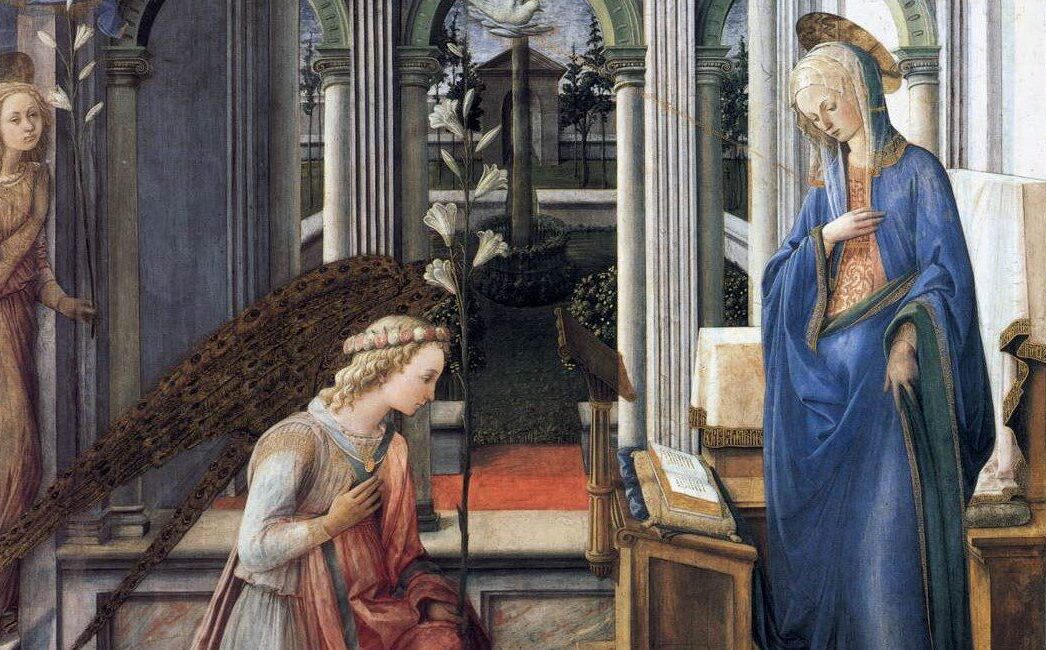In the previous post, we considered what the entrance procession for a typical Sunday Mass might look like if it  were to take place according to “the traditional practice of the Roman Rite” mentioned in no. 42 of the General Instruction on the Roman Missal. In this post, we will examine how the celebrant, deacon, and ministers enter the sanctuary in order to begin Mass.
were to take place according to “the traditional practice of the Roman Rite” mentioned in no. 42 of the General Instruction on the Roman Missal. In this post, we will examine how the celebrant, deacon, and ministers enter the sanctuary in order to begin Mass.
For some, it may seem exaggerated to pay such close attentions to the details of the manner of celebrating Mass. However, those details in the gestures, movements, and postures of the ministers of Mass are like the grammar which gives meaning to the body language we use in celebrating the liturgy. When those gestures, movements, and postures takes place in a coherent and consistent way, they help to make the entire liturgical action more intelligible. For the language of the body is simply one other way of communicating during the course of the liturgy. Together with scriptural and liturgical texts, the music and singing, the art and architecture of the place of celebration, the embodied nature of liturgical prayer itself communicates something important to those who participate in it. Seen in that light, attention to how the body is used to communicate meaning during the course of the liturgy is hardly unimportant.
And so, once the procession has made its way through the body of the church, some gesture of reverence is made upon arriving at the sanctuary. If the Blessed Sacrament is reserved in the tabernacle in the sanctuary, either directly behind the altar or to one side (but still in the sanctuary), one genuflects on the right knee in the direction of the tabernacle. If the Blessed Sacrament is not reserved in the sanctuary, one bows profoundly to the altar from the waist. Servers would make this reverence two by two, or even three at the same time if there is an odd number of servers. Instituted lectors or readers do the same. Those carrying some liturgical object in the procession do not make such a reverence however. Therefore, the cross bearer, the candle bearers, and deacon carrying the Gospel Book do not bow to the altar or genuflect to the tabernacle. Instead, they pause at the entrance of the sanctuary and simply bow their heads before proceeding (cf. General Instruction on the Roman Missal, no. 274).
The Roman Missal indicates that the processional cross may be placed on or near the altar in order to serve as the altar cross for Mass. (This option is difficult to reconcile practically with two other instructions also from the Missal which require only one altar cross, and that such a cross remain on or near the altar when no liturgical rites are taking place. See GIRM nos. 122 and 308.) When the processional cross does not serve as the altar cross, it is placed in a discrete location to the side of the sanctuary or at the entrance of the sacristy itself.
As with the processional cross, it is possible to place the candlesticks carried in the opening procession on or near the altar for Mass. Otherwise¸ it is preferable to place them aside. Traditionally, the candlesticks were placed on the credence table, on the rear corners, where the servers who carried them were seated on stools to either side (A. Mutel and P. Freeman, Cérémonial de la Sainte Messe, Artège, 2012, p. 79). Other servers take their places on benches on the sides of the sanctuary. The instituted acolyte or the server who will hold the missal stands in a position near the priest celebrant, since no. 118 of the GIRM calls for the Missal to be prepared “next to the priest’s chair” prior to Mass. It is always possible to place the Missal on a second credence table in the sanctuary, opposite the main credence table if this is located at some distance from the celebrant’s chair. The deacon carrying the Gospel Book places it reverently face down on the altar (Mutel and Freeman, p. 64). Then, standing slightly to the right side of the altar, he waits for the priest celebrant to join him in order to kiss the altar together with him. If the deacon does not carry the Gospel Book in the procession, he makes the required reverence with the priest at his right side and approaches the altar with him, taking care to remain on the priest’s right side when both approach to kiss the altar.
Having made the required reverence either to the Blessed Sacrament in the tabernacle or to the altar in the absence of the Blessed Sacrament, the priest approaches the altar. If he will celebrate Mass ad orientem, the priest and deacon remain on the nave side of the altar to reverence it with a kiss. If he will celebrate Mass versus populum, he and the deacon walk around the altar and face the nave, kissing the altar from the side opposite the assembly.
Standing at the middle of the altar, with the palms of both hands placed flat on it to his sides, the priest reverences the altar with a kiss, that is, by lightly touching the altar with his closed lips (without making any noise), and then joins his hands upon rising (see P. Elliott, Ceremonies of the Modern Roman Rite, Ignatius Press, 1995, p. 92). If there is a deacon, he kisses the altar at the same time as the priest, standing to his right, although traditionally the deacon did not place his hands on the altar when kissing it (see A. Fortescue, J.B. O’Connnell, and A. Reid, The Ceremonies of the Roman Rite Described, 15th ed., Bloomsbury, 2009, p. 141).
The priest and the deacon then go to their chairs. Historically, the seats of the sacred ministers for Mass were located to their right when Mass was celebrated facing liturgical east. Their seats were placed on the floor of the sanctuary, at a right angle, perpendicular to the altar, either against the wall of the sanctuary or at some distance from it. Their seats might also be elevated on one step in the same position. Similarly, the credence table was placed to the priest’s right side when he stood at the altar. In both cases, this may mean rearranging the position of the chair and the credence table when the priest faces the nave for the celebration of Mass compared to the situation where the priest faces liturgical east.
Once the priest and the deacon have arrived at their seats, the singing or music ends, and a server holds the Missal at the bottom with both hands, open to the first words of the introductory rite for Mass. The server should hold the Missal close to the body. The server should not hold the Missal out with arms fully extended. The upper portion of the Missal usually rests on the chest. In the case of a very short server, the upper portion of the Missal might rest on the server’s forehead (see Fortescue, O’Connell, and Reid, p. 203). In any event, the server will endeavor to hold the book at the necessary height and at the necessary angle for the celebrant to read from it with ease. The server acknowledges the celebrant with a bow of the head upon arriving before him and prior to departing from him (see Mutel and Freeman, p. 41).
The server holding the open Missal stands directly in front of the celebrant, who begins Mass with the sign of the cross. The server should arrive at his position before the celebrant begins the sign of the cross. The server remains standing directly in front of the celebrant while holding the Missal during the entire period of the introductory rites for Mass which concludes with the collect for Mass. This will mean that the server should be old enough and strong enough to hold the Missal for that length of time. In this case, it is best if this function is entrusted to a server with more experience rather than the server with the least experience. The master of ceremonies, a server, or the priest himself, turns the pages of the Missal to the texts needed for the Penitential Act, the Glory to God, and the collect. Normally, in order to turn to the pages or the Missal, or to make use of any liturgical object, the celebrant will use his right hand to do so, holding his left hand on his chest at the same time (see Mutel and Freeman, p. 81, note 26).
This movement of gestures and postures of the clergy and ministers through the nave and into the sanctuary reveals a grammar of reverence and devotion whereby the celebration of Mass is shown to be an orderly participation of the people of God in the work of God. The description of this received pattern of movement into the sanctuary is firmly grounded in the “traditional practice of the Roman Rite” (GIRM, 42) and, while admitting of variation, establishes an orderly arrangement of Christ’s Church, head and members, for the liturgy’s introductory rites. In the next post, we will examine how the introductory rites for Mass might be conducted in order to exemplify the “traditional practice of the Roman Rite.”



